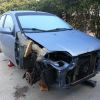As a couple of you know, I had my timing belt slip off. Well I finally got it back home and after some time I got into it yesterday to check the timing and compression.
I reset the timing (crank pointed to bottom and cams pointed to each other). No start. I then checked the compression in cylinder one and four. No pressure. So pretty much I think I have issues (duh!). I can move the engine by hand I don't feel any jamming. So I think I might be able to do a head job and hopefully my pistons are ok. If not I can replace it.
So before I go down this path I need advice on the best way to proceed.
1) should I pull the engine entirely ( I would replace the clutch)
2) Or work with in the car
My biggest concern is removing the exhaust header. The bolts and nuts are pretty much rusted shut. Once I get into that I bet those bolts are going to snap.
So guys who have done this job, advice? I should be able to pull the top end by removing the exhaust, intake headers.



 LinkBack URL
LinkBack URL About LinkBacks
About LinkBacks

 Blue Car
Blue Car
 Reply With Quote
Reply With Quote
